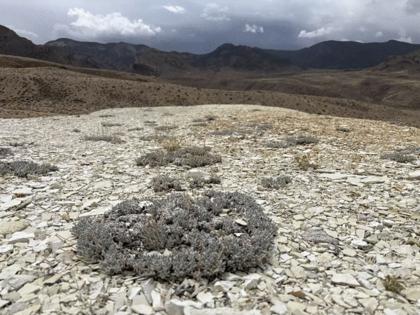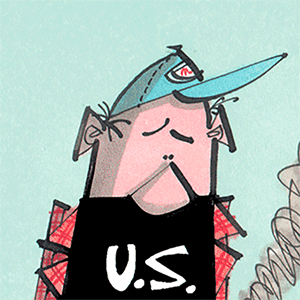Sammy Roth: A climate-saving lithium mine could doom an endangered desert flower
Published in Op Eds
Two scenes. Two storytellers. Two visions for a climate-altered American West.
On an overcast spring morning, I hopped a low metal fence off a lonely dirt road in the Nevada desert, following botanist Naomi Fraga. She assured me she’d done this before — these were public lands, after all. We were 100 miles east of Yosemite, out in the middle of nowhere, except I’d long since learned there’s no such thing as nowhere. The desert may look barren, but its mountains and valleys teem with life. And precious metals.
Fraga led me up a small hill, the soil chalky-white and rich with lithium, a key ingredient in lithium-ion batteries for electric cars. We moved slowly, not wanting to trample any endangered wildflowers.
Wait, were those the flowers? The Tiehm’s buckwheat I’d come hundreds of miles to see?
“Very tiny,” Fraga confirmed. “When it flowers, its flower stalks might come about 4 or 5 inches high.”
“It snows here in this elevation zone,” she added, roughly 6,000 feet above sea level. “It’s a very cold desert, and when it’s cold, Tiehm’s buckwheat is just lying in wait, waiting for spring.”
For a flower that’s spurred high-stakes litigation, detailed scientific study and global news coverage, it was pretty ugly, at least in its dormant winter state. The clumps of gray-green buckwheat looked almost like mold.
For Fraga, the flower’s current appearance is beside the point. Tiehm’s buckwheat doesn’t grow anywhere else in the world — just here, across three square miles of Esmeralda County. She’s enthralled by its role in an ecosystem of pollinators and bighorn sheep. She’s awestruck by its ability to survive winter snow and 120-degree heat.
“I just have an enormous amount of respect for the organisms that make this their home,” she said. “I feel like it brings for a reverence for harsh living, and ways in which life will find a way.”
The question now: Can Tiehm’s buckwheat survive a lithium mine?
Fraga doesn’t think so. Bernard Rowe disagrees.
The day after I met Fraga, Rowe took me to the same area. We drove down the dirt road past the metal fence, to a spectacular basin where his employer, Australia-based Ioneer, is preparing to dig for lithium.
“The good thing is, this is a natural amphitheater, and it is hidden from really everywhere,” Rowe said. “You’ve got the ring of volcanic rocks that completely surrounds this basin.”
Sight lines don’t matter to an endangered flower. But contrary to claims made by conservationists, Rowe said the Rhyolite Ridge mine won’t drive Tiehm’s buckwheat to extinction. He noted that mining activities won’t touch any subpopulations of Tiehm’s buckwheat — although the quarry could come as close as a dozen feet.
“We had to make sure we put buffer zones. We had to map all the plants,” he said.
So who’s right?
It would be easy to make the company look like the bad guy. After all, here’s a profit-seeking foreign corporation seeking to exploit America’s public lands in the name of environmental progress. Potentially at the expense of an endangered species. With only a band of hardy activists standing in the way.
It’s a good story. Arguably an accurate story. And yet...
And yet the climate crisis makes everything complicated. To phase out oil and natural gas — whose combustion fills the air with deadly pollution and fuels devastating storms, wildfires and heat waves — we’ll need enormous amounts of lithium, for electric vehicle batteries and solar energy storage to keep the lights on after dark. Most of the world’s lithium is currently produced in Australia and China, and at destructive evaporation ponds in Chile.
Those geopolitical dynamics help explain why lithium mining has garnered bipartisan support even as President Donald Trump kills other clean energy projects. The Biden administration approved Rhyolite Ridge last year, then backed the developer with a$996-million loan. The Trump administration has let both decisions stand.
Already, Rowe estimated, the U.S. consumes 100,000 tons of lithium carbonate per year for electric car batteries.
“By the time you add in grid batteries, hand tools, recreational vehicles, cellphones ... it will soon be hundreds of thousands of tons,” he said. “And into the future, it’ll be 1 million tons of domestic demand.”
Let’s say the Rhyolite Ridge’s critics are right, and the mine would, in fact, annihilate Tiehm’s buckwheat. Is that a reasonable price to pay for ditching oil-burning cars and shutting down gas-fired power plants?
The answer might depend on your vantage point.
Take Fraga. She was born and raised in Southern California’s San Gabriel Valley and is now a botany professor at Claremont Graduate University. She started doing research in Nevada a few years before the COVID-19 pandemic. She sees Rhyolite Ridge as part of a landscape so unique it might be a national monument were it in California.
Rowe, meanwhile, grew up in an Australian farm town. He was inspired to study geology by a university lecturer’s tales of travel and adventure, which led him to the mining industry. He’s spent 20 years splitting his time between Sydney and Nevada, where he helped identify the value in Rhyolite Ridge’s mineral deposits.
Part of the value is lithium. The rest is boron, a durable, heat-resistant metalloid. Rowe could riff for hours about the vast array of products that require boron, including steel alloys, carpet fibers, car parts, wind turbine magnets and many types of glass, including cookware, windshields, TV screens and thermal insulation.
Right now, Turkey is the world’s top boron producer by far. Rhyolite Ridge was a rare find.
“Most other metal deposits — copper, gold — they can be quite young, in terms of a few million years old. Or they can be hundreds of millions, even a billion years old,” Rowe said. “You don’t find old boron deposits.”
For Rowe, Rhyolite Ridge is treasure buried in plain sight. For Fraga, it’s just the latest example of callous outsiders attempting to exploit Nevada’s public lands — a history that began with silver mining and continues with housing development, solar farms and nuclear waste storage. Nevada is already home to America’s only active lithium mine, not far from Rhyolite Ridge. The Thacker Pass mine is also under construction near the Oregon border.
Angelenos driving electric vehicles ought to think about how their choices affect Nevada, Fraga suggested.
“There’s a real tension there, where we need to avert the worst of the climate crisis. But in doing so, we can cause real harm to ecosystems,” she said.
So how do we resolve that tension?
I put off writing this column for three months because I didn’t have a good answer. How could I defend the mine when it might doom an endangered species? Yet how could I condemn it when we need lithium, and when so few large-scale clean energy projects don’t face environmental conflicts?
As far as the sparring parties are concerned, the facts speak for themselves. Ioneer points to a biological opinion from the U.S. Fish and Wildlife Service concluding that its mine is “not likely to jeopardize the continued existence” of Tiehm’s buckwheat or “result in the destruction or adverse modification of its critical habitat.”
Conservationists counter that when the Fish and Wildlife Service declared the flower an endangered species in 2022, the agency described “mineral exploration and development” as one of the “greatest threats” to the flower. The Center for Biological Diversity, the Western Shoshone Defense Project and Great Basin Resource Watch sued federal officials over their approval of the mine last year, contending they rushed the environmental review.
It’s possible we’ll never know who’s right. Ioneer is scrambling to secure new funding after the South African firm Sibanye-Stillwater — which was supposed to invest $490 million — backed out this year amid falling global lithium prices. Ioneer said in July that it wouldn’t start construction until at least March. If and when the company is ready to start digging, the groups in the lawsuit could ask the judge to block construction.
But whatever happens at Rhyolite Ridge, these types of questions aren’t going away — especially in the American West, where public lands have traditionally supplied big cities with energy, water and food. We’ll need to be more thoughtful than ever about how we use land. We’ll need to get comfortable evaluating trade-offs.
In an ideal world, we’d never have to choose between lithium mines and lovely flowers. Or at least, we’d find ways to resolve these types of conflicts amicably — and quickly, because climate chaos is coming fast.
Sometimes it’s possible. Alas, sometimes we’ll have to choose.
____
©2025 Los Angeles Times. Visit at latimes.com. Distributed by Tribune Content Agency, LLC.




























































Comments